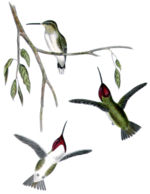The Costa’s Hummingbird (Calypte costae) is a species of hummingbird.
The Costa’s Hummingbird is very small, a mature adult growing to only 3 to 3½ inches in length. The male Costa’s has a mainly green back and flanks, a small black tail and wings, and patches of white below their throat and tail. The male Costa’s Hummingbird’s most distinguishing feature is its vibrant purple cap and throat with the throat feathers flaring out and back behind its head. The female Costa’s Hummingbird is not as distinct as the male, having grayish-green above with a white underbelly.
The Costa’s Hummingbird is fairly common in the arid brushy deserts and any nearby gardens of the Southwestern United States and the Baja California Peninsula of Mexico.

Female (upper) and males
The Costa’s Hummingbird constucts a small cup-shaped nest out of plant fibers and down and coated with lichen to hold it together. The nest will be situated above ground on a yucca stalk or tree limb. The female lays just two eggs, which are white in color, which she will incubate for 15 to 18 days before the young hatch. The young Costa’s Hummingbirds leave the nest after 20 to 23 days.
Like all other hummingbird species the Costa’s Hummingbird feeds on flower nectar and any tiny insects that it happens to find in the flower petals.
The binomial commemorates French nobleman Louis Marie Pantaleon Costa, Marquis de Beauregard (1806-1864).
| Costa’s Hummingbird Conservation status: Least concern |
||||||||||||||
|---|---|---|---|---|---|---|---|---|---|---|---|---|---|---|

Public domain image
|
||||||||||||||
| Scientific classification | ||||||||||||||
|
||||||||||||||
| Calypte costae (Bourcier, 1839) |
Costa’s Hummingbird in Sunlight
Click Wikipedia, the free encyclopedia, to view original editable article – All text is available under the terms of the GNU Free Documentation License

